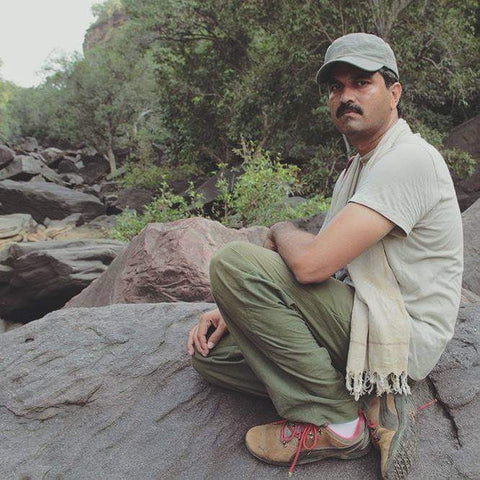About the Ranthambore Collection
Payal, our Founder, knew that she wanted to support tiger conservation in an ECOLOGIES Collection. But she didn't know where to base the collection or who to support until she met Valmik Thapar, one of India's leading conservationists and tiger experts. He gave her a lot of current information on the plight of tigers in India today, and encouraged her to visit Ranthambore National Park to meet Dr. Dharmendra Khandal (shown in photo below), a conservation biologist of Tiger Watch, a local conservation organization based outside of Ranthambore. This is where this collection started.
Over several trips, Payal experienced and was entranced by Ranthambore's beautiful landscape and wildlife, while also getting to know Dr. Khandal and his wife, Divya, and the work of Tiger Watch.
HISTORY of RANTHAMBORE

In the desert state of Rajasthan in India, where the Vindhya Plateau and the Aravalli Hills meet, is the ancient fort of Ranthambhore. This fort has a rich history spanning more than 1000 years, and is where the national park and tiger reserve gets its name. It sits atop a 700 ft tall hill within the park and is believed to have been built in 944 AD. Being the gateway to Central India, many rulers coveted its strategic location and fought battles for its control.
In later years the jungles around Ranthambhore Fort became the private hunting preserve for the Maharajas (royalty) of Jaipur. The forests were teeming with wildlife, but sadly the British along with the Indian royals hunted the tiger to near extinction.
Thankfully the government of India banned tiger hunting in 1970, and Project Tiger was launched in 1973 to save tigers. At this time there were no more than 1,827 tigers left in the wild. Ranthambhore became one of the first of nine parks to be designated as a Tiger Reserve. In 1980, the reserve along with adjacent areas was established as a National Park to protect the endangered Bengal Tiger.
A dry deciduous forest bordered by two rivers, Ranthambore National Park's landscape varies widely from thick forest to open grasslands, savannah, streams, and perennial lakes. Project Tiger was successful and tigers and other wildlife were thriving until the 1990’s, when poaching brought the tiger population into crisis once again. Tiger Watch and Dr. Khandal were instrumental in bringing down the poaching ring among many other pursuits that have now resulted in a resurgent tiger population once again.
TIGER WATCH
Tiger Watch is a non-governmental organization (NGO) founded in 1998 to protect the wildlife in the Ranthambhore Tiger Reserve and adjoining areas.
When the poaching crisis was revealed, Tiger Watch discovered that the poaching was being carried out by the nomadic Mogya tribe, who live in the region and are expert hunters. By taking a holistic approach and helping the Mogya tribe find alternate livelihoods they were able to curtail the poaching. Tiger Watch got to know the Mogya community, and started programs to support them. Many ex-poachers are now working for Tiger Watch as trackers and nature guides, and Tiger Watch has established an education program for the Mogya children to end the generational cycle of poaching as a trade. They have also established a women’s empowerment program and handicraft program where the women learn skills to create and sell their own handicraft items.
Tiger Watch members have provided crucial assistance to both the Forest Dept. & the State Police in anti-poaching operations since 2005. They have conducted many successful and dangerous anti-poaching raids & they secured the future of Ranthambhore when it was at its most vulnerable.
Beyond anti-poaching, Tiger Watch conducts wildlife monitoring, biodiversity exploration, research, assists the local community, and provides aid in cattle compensation to mitigate man-animal conflicts.
DHONK

Divya Khandal, wife of Dr. Dharmendra Khandal, is just as involved with supporting the local community. She founded Dhonk, a Craftmark certified enterprise that employs the wives of ex-poachers and other members of the region. With few opportunities outside of tourism in this area, Dhonk fills a necessary void. Women are taught new skills such as sewing and hand block printing, and the products they make are sold by Dhonk. In turn, Dhonk donates a percentage of sales to Tiger Watch. Dhonk also runs a micro financing program that allows people to take out loans of up to $1000, which has been a great help to the local community. We are very excited to say that we partnered with Dhonk on all our hand block pieces in this collection! You can shop the styles here.
TODAY'S CHALLENGES FOR RANTHAMBORE


Although poaching has significantly decreased in Ranthambore due to the efforts of Tiger Watch, it has not been eliminated. The demand for tiger parts as trophies, status symbols and as an ingredient in traditional Chinese medicine is driving the tiger to the brink of extinction in all its habitats. Ranthambore also faces poaching of other animals including leopards and pangolins, the most illegally trafficked animal on earth. In the last couple of years different methods of killing wildlife have emerged such as crude gunpowder bombs which pose a very dangerous threat to humans as well.
The other main threat to Ranthambore's wildlife is loss of habitat and increased conflict between humans and animals.
Ranthambore is like an isolated and protected island which is surrounded by 90 villages totaling 200,000 residents. Conflict arises when farmers and villagers lead their cattle into the rich vegetation of the park to graze. The lush vegetation of the park is degraded by the cattle which herbivores depend on for food and nourishment, and diseases can also be spread from the cattle to the wildlife. Moreover, depletion of the tiger’s natural prey will often cause tigers to hunt domestic livestock, especially if the cattle are brought within the park's boundaries. The loss of even one one cow is a huge blow to a farmer and they often retaliate by trying to poison tigers. And to prevent wild animals from destroying their crops, some farmers have installed illegal electric fences that will kill any animal that comes into contact with a fence.
The other big problem is that the tiger population is isolated from other wild populations. Without the ability to breed with other populations, tigers in Ranthambore will not survive. So Tiger Watch is actively working on developing wildlife corridors, linking the isolated areas and allowing the movement of wildlife.
Despite all these challenges, Tiger Watch is working hard every day to protect wildlife and landscape, and they are the best hope for Ranthambore's survival. If you would like to donate and support their work directly, you can contact them here: tigerwatchindia@yahoo.co.in




